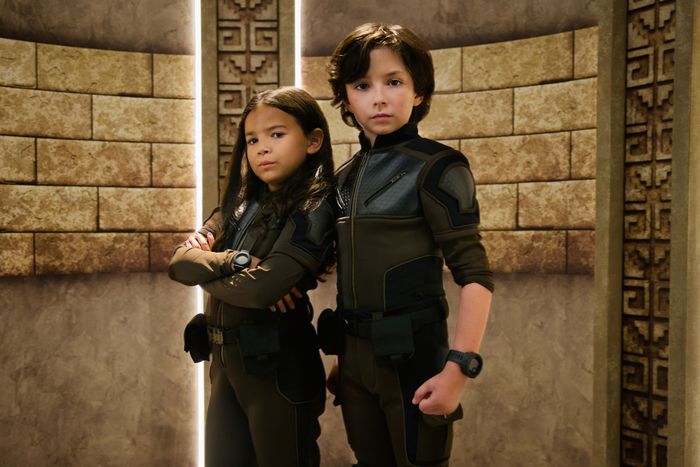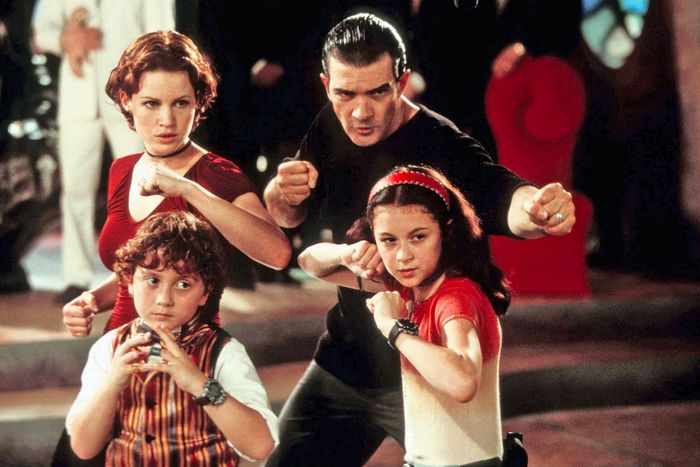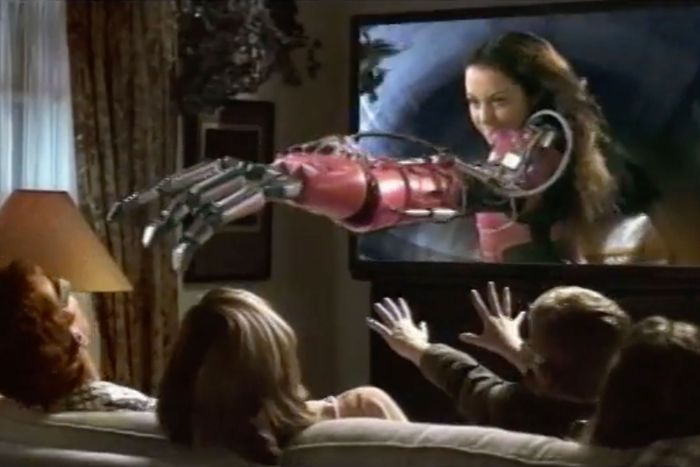
Spy Kids: Armageddon, the fifth installment in the long-running Spy Kids franchise, arrived on Netflix over the weekend, a little over 22 years since the series debut in the spring of 2001. For anyone whose sum-total knowledge of Spy Kids is a vague memory of a single child-friendly action-adventure flick involving Antonio Banderas with a little mustache and a cool leather jacket, the news that there are four of these movies already may come as something of a surprise ÔÇö let alone that thereÔÇÖs apparently demand enough to continue making them for the streaming generation.
But itÔÇÖs true: The original Spy Kids, written and directed by Robert Rodriguez and starring Banderas alongside Alexa Vega, Daryl Sabara, Carla Gugino, and Danny Trejo, was followed by the (largely) successful sequels Spy Kids 2: The Island of Lost Dreams (2002), Spy Kids 3-D: Game Over (2003), and Spy Kids: All the Time in the World (2011), each of them weirder, wackier, and more experimental than follow-ups to a childrenÔÇÖs espionage comedy have any right to be. These films are anarchic, sui generis novelties with a unique vision and a will to push technological boundaries. TheyÔÇÖre also zany kidsÔÇÖ movies that feature Alan Cumming as a deranged Willy WonkaÔÇôesque TV host and an army of giant CGI ninja thumbs.
Armageddon marks a full-blown franchise reboot, starting the series anew ÔÇö and maybe opening the door for another bunch of sequels ÔÇö with an all-new cast following the blueprint of the originals. But if you want to catch up on the bizarro glory that is the franchise in its classic incarnation, weÔÇÖve got you covered. HereÔÇÖs everything you need to know about some of the most idiosyncratic childrenÔÇÖs movies Hollywood has ever churned out.
So what was the deal with the first one again?
The original Spy Kids was a high-concept childrenÔÇÖs action-adventure movie about the adolescent kids (Vega and Sabara) of a pair of elite secret agents (Rodriguez and Gugino). When the parents are captured by the nefarious Fegan Floop (Cumming) and his right-hand man Alexander Minion (Tony Shalhoub, having himself a grand old time), itÔÇÖs up to the children to inherit their birthright and step into the role of pint-size badasses. The whole thing has the manic, over-the-top energy of a Saturday-morning cartoon, with lurid colors, canted camera angles, and nightmare-inducing creature costume work that looks like a cross between Alice in Wonderland and Tim and Eric Awesome Show, Great Job! In short, itÔÇÖs pleasant, a little bit juvenile, and incredibly strange.
But  was it good?
Kind of, yeah! The infectious gusto of the first Spy Kids made it very likable, if sometimes grating, and its whimsical style seemed like the product of real care and enthusiasm. ChildrenÔÇÖs movies can feel designed by committee or function primarily to sell toys. Spy Kids is an exception. Roger Ebert, famously hard to please with this genre, commended it as ÔÇ£an exuberant, colorful extravaganza, wall-to-wall with wildly original sets and visual gimmicks, and smart enough to escape the kidsÔÇÖ film category and play in the mainstream.ÔÇØ
How did it get made?
It was a bit of a passion project for writer-director Rodriguez, who had wanted to make a fantastical kidsÔÇÖ movie for years and was committed to seeing it done the right way. He produced it himself under the aegis of his own Troublemaker Studios.
Wait, sorry, the Robert Rodriguez?
Of El Mariachi and Desperado fame, yes. Hard as it may be to believe, Spy Kids was directed by the same guy who made From Dusk Till Dawn, Sin City, and the first half of Grindhouse.
Was he involved with the sequels?
Yes, all of them. Rodriguez went on to direct every single one of the Spy Kids movies, up to and including the latest reboot ÔÇö a rarity for any long-running franchise but understandable when you consider how personal the films are to the guy.
What are the sequels like?
The generous way to put it is that they vary in quality. Spy Kids 2 has much the same stylistic verve as its predecessor, this time telling the story of a double agent (played by Beavis and Butt-Head creator Mike Judge!) who seeks the Transmooker, an all-powerful device that can control all electronics on the planet. Steve Buscemi shows up as a reclusive scientist who helps the kids. The third movie is about an all-new virtual-reality video game with mind-control powers (the big bad is played by Sylvester Stallone in not his finest hour), while the fourth is a soft reboot that finds the original kids grown up and helping a new set of youngsters save the world from a device that can freeze time.
What makes them unique?
A lot, surprisingly. Spy Kids 2 was, strangely enough, one of the first wide-release Hollywood features shot entirely on digital video; Rodriguez saw how the technology had been used by George Lucas on Star Wars: Episode II ÔÇö Attack of the Clones. He shot it on a Sony HDW-F900 camera, acting as his own cinematographer, and edited the whole thing by himself. Keep in mind that the industryÔÇÖs transition from film to digital was still many years off at this point and that using a largely untested technology in this way for a blockbuster family film was considered a major gamble. As if attempting to outdo himself, Rodriguez released the third movie in 3-D.
But werenÔÇÖt there a ton of 3-D movies back then?
The digital 3-D boom didnÔÇÖt really kick off until the release of Avatar in 2009. Back in the summer of 2003, putting a movie out in 3-D was practically unheard of; pretty much the only films to use the technology were low-budget horror flicks relying on a wacky gimmick and edutainment titles put out in IMAX at theme parks and science centers. Even crazier is that Spy Kids 3-D was released that way not only in theaters ÔÇö where 3-D glasses could be distributed upon entry, the way itÔÇÖs still done now ÔÇö but on home video with a few pairs of 3-D glasses included in the DVD box.
Did the 3-D look good?
Oh man, no. No no no. The 3-D stuff was mainly characters jabbing a finger toward the screen or throwing stuff at the camera. And this was anaglyphic 3-D, which uses those crappy cardboard glasses with one red lens and one blue. But please, I implore you, check out how this was advertised:
Needless to say, itÔÇÖs not an accurate depiction of the experience.
Did the fourth movie do anything similarly out there?
There was an eight-year gap between Spy Kids 3-D and Spy Kids: All the Time in the World, and of course by 2011, 3-D was everywhere. So Rodriguez went one step further and made the movie in 4-D.
Uh, what is the fourth D?
Smell. All the Time in the World was released in ÔÇ£Aroma-scope,ÔÇØ which allowed audiences to smell the world of Spy Kids while watching. Moviegoers were given a scratch-and-sniff card with numbered segments as they entered the theater, and during the course of the film, those numbers would appear onscreen, prompting viewers to scratch and, yes, sniff. Somehow, unlike digital video and 3-D, this trend did not catch on.
So what about the newest one?
Armageddon doesnÔÇÖt employ any novel tech component. But as the first Spy Kids movie to skip theaters and premiere directly on Netflix, it has the distinction of being the first in the franchise to belong firmly to the modern streaming era ÔÇö not exactly on par with a fifth dimension but something novel in its own right.
WhatÔÇÖs it about?
This┬áSpy Kids┬áis a full-fledged franchise reboot embarking on a new story from the beginning. The plot combines elements of several of the previous installments ÔÇö the parental kidnapping from the first, the electronics-controlling MacGuffin from┬áSpy Kids 2, and most prominently, the virtual-reality video game from┬áSpy Kids 3-D, a digital world the heroes enter toward the end of the film. None of the original cast has returned, and the only familiar character here┬áis Devlin, the secret-agent commander played in the original movies by George Clooney and in┬áArmageddon┬áby D.J. Cotrona.



